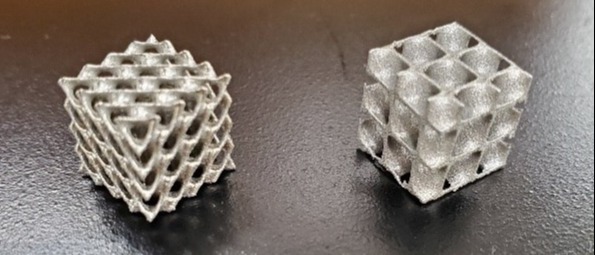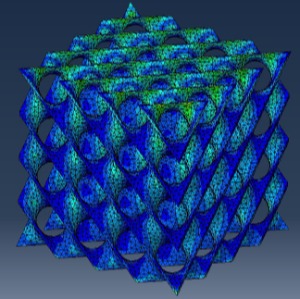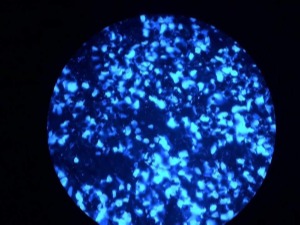DataBytes Newsletter
Cedarville University Biomedical Engineering Partners with Local 3DP Implant Manufacturing Company
In the medical industry, there is a growing need for affordable implants that are customized to each patient. Just as each bone defect is unique, so is each patient in need of an implant. Additive manufacturing (AM) allows for the creation of more complex geometries than traditional manufacturing methods. With the advancement of three-dimensional printing (3DP), manufacturers are now able to print Titanium, a biocompatible and historically successful implant material. This new and emerging field is where the students and faculty at Cedarville University partner with Tangible Solutions, a Fairborn based company leading the way in the technology of titanium devices for human implantation.
“The partnership between Cedarville University with expertise in implant design, mechanobiology and cell culture of human bone cells is a good fit with the cutting-edge 3DP technology of Tangible solutions,” said Dr. Timothy Norman, Distinguished Professor of Mechanical and Biomedical Engineering. Dr. Norman, an orthopedic engineering researcher for 30 years, has teamed up with Dr. Rocco Rotello, Associate Professor of Pharmaceutical Science from the Cedarville’s School of Pharmacy, also an experienced researcher in the area of pharmaceuticals. “Pooling the strengths of both schools, along with many talented students and alumni from engineering and science, has put us in a position to develop some impactful research,” remarked Dr. Norman.
The partnership has resulted in two emphasis areas for the Cedarville team: 1) design of implant scaffolding structures and 2) assessing the bone cell growth potential on 3DP titanium implants. The team is developing triply-periodic minimal surface (TPMS) structures (Fig. 1) that have continuous smooth surfaces in which the mean curvature of the surface is zero. TPMS structures have a high ratio of surface area to volume, allowing more room for bone cells (osteoblasts) to adhere to the structure. TPMS are also preferred for biological applications, because they have a long fatigue life, are less prone to stress risers and concentrations, and encourage homogeneous cell generation. In addition, TPMS stiffness can be designed to be comparable to bone, which should promote bone remodeling and implant sustainability. A significant challenge in the design of implants that promote bone ingrowth is to design for biomimicry. Biomimicry requires an understanding of the mechanobiological function of natural bone tissue. In order to promote bone cells to grow within a titanium scaffold, according to mechanostat theory the strain should be within the preferred range. Engineering students use complex computer models (Fig. 2) to predict scaffold strain under load, which is used to provide valuable feedback for scaffold redesign. In order for an implant to be successful, it must be able to sustain cell life. The second emphasis area of the Cedarville team is to study the growth and survivability of osteoblasts (bone cells) after attachment to 3D printed titanium surfaces with variations in roughness. Results to date have been encouraging and have verified that human osteoblasts survive (Fig. 3), proliferate, and maintain phenotype on 3D printed titanium specimens. These findings are groundbreaking and among the first to assess cell growth on 3DP titanium.
Dr. Norman praised the work of current and former students. He mentioned the 2019-2020 senior design team consisting of Trenton Classen, Andrew Fretwell, Brooke Hieronymus, Brianna Holst, and Joel Pensworth and current team members Bryson Adkins, Connor Cohea, David Helmers, Caleb Pendleton, Brendan Toungate, and Grant Trautman. Sarah Seman, a senior molecular biology student is helping these teams and others in the area of cell culture. “Sarah came to Cedarville as a freshman and wanted to get involved with research from day one. She’s a senior now and has become a very experienced researcher thanks, to the mentoring of Dr. Rotello,” explained Dr. Norman. Sarah will be the first non-engineering major to receive the biomedical engineering minor. It is noteworthy that the Director of Engineering at Tangible Solutions, Matthew Shomper, is a Cedarville alumni. Matthew graduated with a Bachelor of Science in Mechanical Engineering with a minor in biomedical engineering.
The partnership between Cedarville University students and faculty and Tangible solutions has led to significant advancement in the area of the development of 3DP of titanium implants. Cedarville’s team has been able to successfully biomimic the mechanical response of bone with TPMS lattices, which has been shown to promote cell growth and sustainability. These TPMS lattices were developed to have high porosity and surface area conducive to cell proliferation. The research is providing a framework for designing customizable implants with mechanobiology criteria.

Fig. 1. Examples of Titanium scaffold structures (courtesy of Andrew Fretwell).

Fig. 2. Numerical analysis maximum stresses in (Courtesy of Joel Pensworth).

Fig. 3 Fluorescent microscopy view of cells on 3DP titanium. (Courtesy of Brianna Holst and Sarah Seman).



















